You’re passionate about stargazing. Ohio has some excellent stargazing spots. The night sky, filled with stars, planets, and other celestial wonders, beckons you for a closer look.
But there’s a hitch. Light pollution is clouding the natural beauty of Ohio’s night skies. The glow from city lights, street lamps, and even your neighbor’s porch light can wash out the details you crave to see. It’s frustrating when you can’t find that perfect, dark location for a night under the stars.
How do I use the Ohio Dark Sky Map?
To effectively use the Ohio Dark Sky Map, you’ll want to focus on areas with low Bortle scale ratings, typically between 1 and 3. These zones offer the darkest skies and are ideal for stargazing. The map is user-friendly and often features zoom and pan options to help you pinpoint specific locations.
This article is your ultimate guide. Using the Light Pollution Map Ohio, you’ll discover the best spots to escape the glare and connect with the cosmos. With this knowledge, you’ll know exactly where to go for an unforgettable stargazing experience.
Let’s dive right in.
Navigating Ohio’s Light Pollution Map: A Stargazer’s Guide
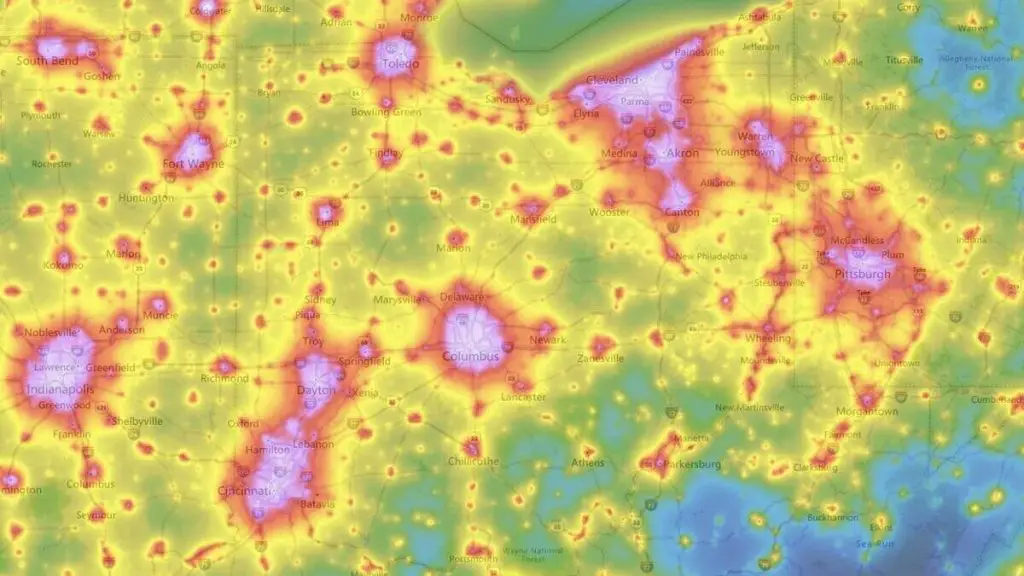
I’ve spent many nights stargazing in Ohio, and I can tell you that finding the perfect spot hinges on knowing how to read a light pollution map. Let’s look at how to use these maps effectively and discover some great locations for gazing at the night sky.
Light pollution maps show areas with different levels of sky brightness, measured using the Bortle scale. Lower numbers represent darker skies, making it easier to spot stars and other celestial wonders. Ohio’s Dark Sky Parks and Places list provides information on locations with low light pollution levels.
Here are some tips for reading light pollution maps and finding the perfect stargazing spots:
- In my stargazing adventures, I’ve found that areas with low Bortle scale ratings (1-3) offer the most breathtaking views. These areas have the darkest skies and offer the most spectacular views of the heavens.
- Use zoom and pan features on interactive light pollution maps to explore Ohio’s night sky conditions in detail. This feature helps you pinpoint specific locations and plan your stargazing adventure.
- I always check the weather before heading out; clear skies and minimal cloud cover have made some of my stargazing trips magical. Clear skies and minimal cloud cover make for the best observing conditions.
- Follow road and park regulations when traveling to stargazing locations. Some spots may require permits or have restricted access during certain times.
Now that you’re armed with this knowledge, it’s time to grab your telescope, gather a cozy blanket, and head out for a magical evening of stargazing in Ohio’s beautiful dark-sky areas. Happy exploring, and may the stars shine brightly for you tonight!
Ohio’s Prime Stargazing Spots
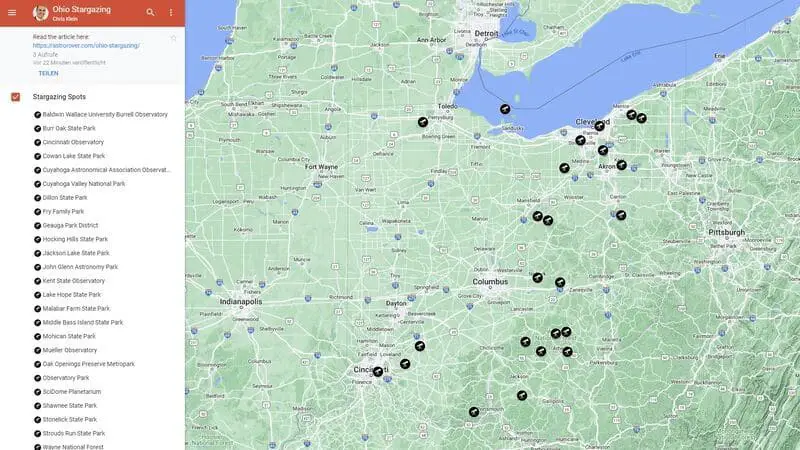
For a comprehensive list, read my article on the best places to stargaze in Ohio.
Escape City Lights: The Darkest Corners of Ohio
Having explored various locations, I vouch that when it comes to stargazing in Ohio, some spots genuinely outshine the rest. One such gem is the John Glenn Astronomy Park, a secluded haven for night sky enthusiasts.
FREE STARGAZING CHECKLIST
My 5-page Stargazing Checklist will enhance your astronomical observations.
Follow this free checklist to navigate the night sky with confidence, clarity, and a sense of preparedness for a rewarding stargazing experience.

Lose yourself under a canopy of stars in this serene and enchanting setting. Another treasure is the idyllic Burr Oak State Park, nestled within Wayne National Forest. With over 2,593 acres of wooded hills and valley farms, it’s a stargazer’s paradise.
Urban Expansion’s Toll: Where Development Meets the Cosmos

It breaks my heart to see how urban expansion increasingly threatens the beauty of Ohio’s night skies. Light pollution from growing cities and suburbs obscures the celestial wonders and makes stargazing more challenging. But the battle isn’t lost.
The International Dark-Sky Association (IDA) works to protect dark skies by certifying parks and preserves that meet their guidelines.
Ohio has IDA-certified Dark Sky Parks like Observatory Park, a sanctuary for stargazers. These parks prioritize light pollution reduction and promote the importance of star-filled skies.
To help save Ohio’s darkest skies for future generations, you can:
- Visit and support IDA-certified parks
- Use dim, shielded outdoor lighting at home
- Spread awareness about the impact of light pollution on astronomy
Hosting Stellar Astronomy Events in Ohio
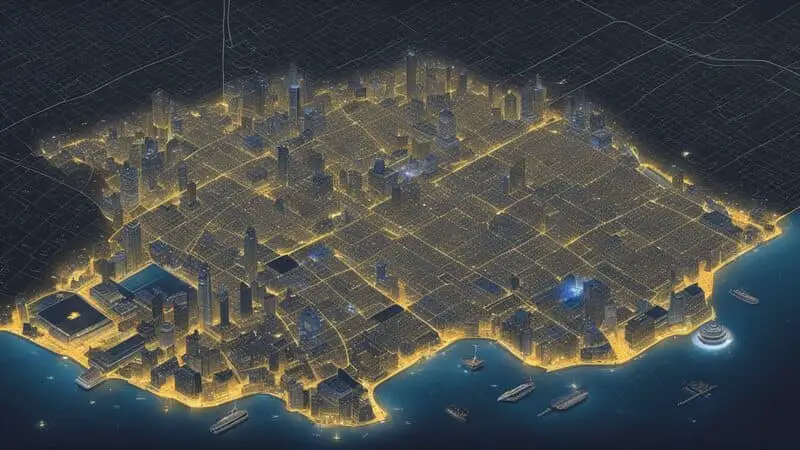
Location Scouting: Picking Perfect Places Amidst City Glow
I’ve faced the challenge of light pollution while scouting for the perfect stargazing location in Ohio, but it’s manageable. When scouting for locations, compare the Dark Sky Map to the Bortle Scale Chart to find the darkest sky areas. IDA-certified parks, such as Cowan Lake State Park, are fantastic for stargazing events.
Here are a few other factors to consider when picking the perfect place for your astronomy event:
- Accessibility: Ensure your chosen location is easy for guests to find and reach.
- Safety: Look for areas with low crime rates and well-maintained facilities.
- Weather: Pick a location with clear skies and low humidity for the best viewing conditions.
Light Pollution in Education: Using Maps for Effective Teaching
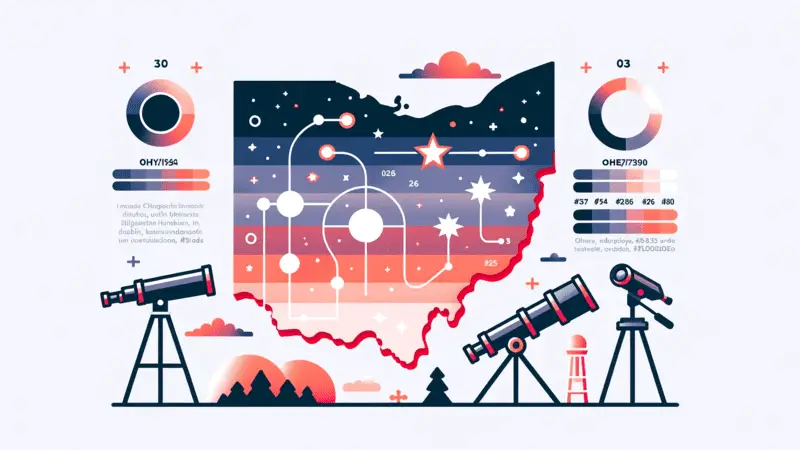
Incorporating light pollution maps into your astronomy events can be a valuable educational tool.
The Light Pollution Map provides detailed information on the levels of light pollution for specific areas, making it an excellent resource for understanding how light pollution impacts stargazing and the environment.
Here are some ways you can use light pollution maps in your events:
- Show attendees a side-by-side comparison of dark skies versus light-polluted areas, demonstrating the stark difference in stargazing conditions.
- Discuss the adverse effects of excessive artificial light on wildlife, ecosystems, and human health.
- Explain the different levels of light pollution on the Bortle Scale and how each level affects night-sky viewing.
By incorporating these maps and other educational components, your stargazing event will be not only an entertaining experience but also an opportunity for attendees to learn about the importance of preserving dark skies in Ohio.
Remember, a successful astronomy event combines excellent location scouting with an engaging learning experience. Keep these tips in mind to create an unforgettable stargazing event for your guests.
The Battle Against Ohio’s Light Pollution

Ohio’s High-Pollution Hotspots: Areas That Challenge the Night Sky
Ohio has its fair share of light pollution, painting the night sky with an artificial glow.
You can use the light pollution map to pinpoint high-pollution hotspots and find the areas with the most significant light pollution. The brighter the color on the map, the worse the pollution. So, when planning your next stargazing trip, avoid these areas to enjoy a clearer view of our universe.
Sustainable Lighting Advocacy: Spearheading Changes for Starry Nights
Keeping the night skies unspoiled requires effective advocacy, and the International Dark-Sky Association (IDA) is uniquely positioned to help. They have an Ohio chapter dedicated to protecting the state’s nighttime environment from light pollution. As a knowledgeable cosmic enthusiast, you can lend your voice to their cause.
Here are some tips to help you become an advocate for starry nights:
- Educate yourself and others: Share your knowledge of light pollution and its effects on wildlife, energy waste, and stargazing quality.
- Be an example: Implement sustainable lighting practices around your home, like using energy-efficient bulbs and reducing unnecessary outdoor lighting.
- Collaborate and connect: Keep yourself informed about IDA’s efforts in Ohio and find events to attend or other like-minded individuals to work with.
- Spread the word: Use social media and your network to raise awareness about light pollution and ways to combat it.
So, embrace your role in the battle against light pollution in Ohio! Every little effort makes a difference, bringing us closer to clear, starry skies we all cherish.
Astrophotography Challenges in Light-Polluted Ohio

What are the challenges of astrophotography in light-polluted Ohio?
Astrophotography in light-polluted Ohio presents specific challenges, such as reduced sky brightness and limited visibility of celestial objects. However, using light pollution filters and optimizing camera settings can help you capture stunning cosmic images even in less-than-ideal conditions.
Photo-Perfect Dark Sky Locations: Where the Camera Meets the Stars
Finding the ideal spot for astrophotography in Ohio can be tricky due to light pollution, which significantly affects the sky’s brightness and limits your ability to capture the cosmos. But worry not, star hunters! Ohio has some dark sky locations that offer better conditions for night sky photography. To give you a head start, check for spots on the Clear Sky Chart.
Some locations you might consider include:
- Ohio Dark Sky Parks
- Observatories in remote areas
- Rural, low-light areas with minimal urban glow
Trust your camera and yourself, and together, you’ll snap some stunning galactic photos.
Overcoming Ohio’s Glow: Techniques for Clearer Cosmic Captures
Light pollution in Ohio doesn’t mean you should pack away your camera. There are techniques to overcome this obstacle and achieve clear, cosmic captures.
Here are a few tips to help you get the best shots despite the glowing skies:
- Equipment matters: Invest in a light pollution filter for your camera, which helps cut through the unwanted light and enhances the desired celestial subjects.
- Embrace the darkness: Use the lowest possible ISO setting to reduce noise. Increase your camera’s limiting magnitude by opting for longer exposure times and wider aperture settings.
- Post-processing magic: Make the most out of editing software to reduce the effects of light pollution in your images further. Tools like Photoshop and Lightroom can work wonders by adjusting levels, noise reduction, and selective filtering.
Following these tips and staying persistent will let you shine through Ohio’s light-polluted skies, turning your astrophotography dreams into a visually stunning reality.
Harnessing Technology for Darker Ohio Skies
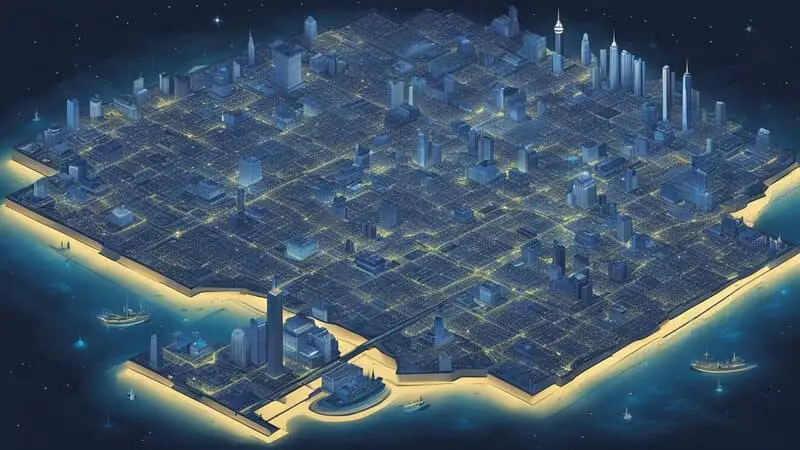
Digital Light Pollution Maps and Apps: Navigating the Nocturnal Landscape
Do you love stargazing in Ohio? Battling light pollution can be a challenge, but thankfully, technology is here to help! Using digital light pollution maps and apps, you can quickly find the perfect spot for a clear, dark sky.
I regularly use these user-friendly tools to check light pollution levels, and they’ve been invaluable in helping me find the best stargazing sites.
Community Movements: Joining Ohio’s Fight for Natural Night Skies
The fight against light pollution isn’t a solo mission – it’s a community effort! By supporting and joining movements like the International Dark-Sky Association’s Ohio chapter, you can create a darker, more star-filled future for the state.
Here’s how you can get involved:
- Participate in local astronomy clubs and events
- Advocate for darker skies by raising awareness of light pollution
- Help reduce light pollution in your neighborhood by using energy-efficient, dark-sky-friendly outdoor lighting
Remember, you don’t need to be an expert in astronomy to make a difference. By taking small steps to reduce light pollution, you’ll not only improve Ohio’s night skies but also contribute to better wildlife habitats and energy efficiency. So, for the love of the stars, let’s work together and reclaim the natural night skies over Ohio.
Frequently Asked Questions
How reliable is the Bortle scale for finding good stargazing spots?
The Bortle scale is a reliable tool for identifying ideal stargazing locations. It measures sky brightness on a scale of 1 to 9, with lower numbers indicating darker skies. Using it with light pollution maps can significantly enhance your stargazing experience.
Can I make a difference in reducing light pollution?
Yes, individual efforts can make a significant impact on reducing light pollution. Simple actions like shielded outdoor lighting and spreading awareness can contribute to preserving dark skies. Your involvement can inspire others to join the cause.
Are digital light pollution maps and apps easy to use for beginners?
Digital light pollution maps and apps are user-friendly and designed for all levels of stargazers. They provide detailed information on light pollution levels, helping you find the best spots for a clear, dark sky, even if you’re new to the hobby.
Final Words: Light Pollution Map Ohio
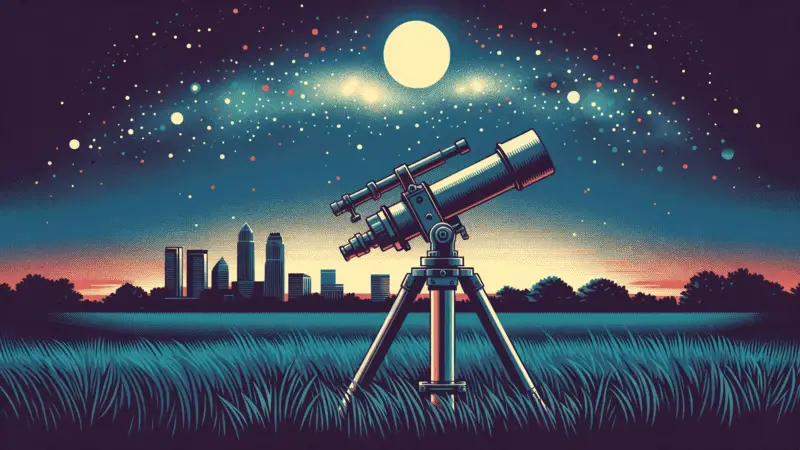
You don’t have to let light pollution steal your stargazing joy in Ohio. With the right tools like the Light Pollution Map and some planning, you can find those hidden gems where the night sky truly comes alive.
I’ve been there, telescope in hand, marveling at the celestial wonders that still manage to break through the glow. So grab your gear and let this guide lead you to the dark corners of Ohio, where the stars shine the brightest.
Happy stargazing!
Additional Dark Sky Maps you may enjoy:
- Arizona Dark Sky Map
- California light pollution map
- Florida light pollution map
- Indiana light pollution map
- Kentucky light pollution map
- Michigan light pollution map
- Nevada light pollution map
- New Mexico light pollution map
- Pennsylvania light pollution map
- Texas light pollution map
- Utah light pollution map




